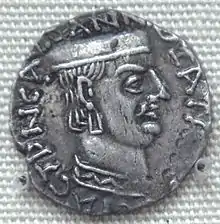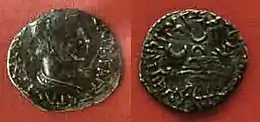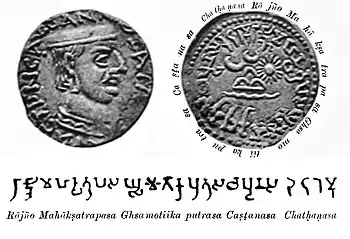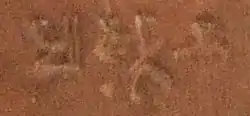Chashtana
Chashtana (Greek: CIACTANCA, Brahmi: ![]()
![]()
![]() Ca-ṣṭa-na, Kharosthi: 𐨖𐨟𐨣, IAST: Ca-ṣṭa-na)[4] was a ruler of the Saka Western Satraps in northwestern India during 78-130 CE.[5] He was satrap of Ujjain during that period. Among the modern scholars, the beginning of the Saka era is widely equated to the ascension of Chashtana (possibly to Mahakshatrapa) in 78 CE.[6]
Ca-ṣṭa-na, Kharosthi: 𐨖𐨟𐨣, IAST: Ca-ṣṭa-na)[4] was a ruler of the Saka Western Satraps in northwestern India during 78-130 CE.[5] He was satrap of Ujjain during that period. Among the modern scholars, the beginning of the Saka era is widely equated to the ascension of Chashtana (possibly to Mahakshatrapa) in 78 CE.[6]
| Chashtana | |
|---|---|
| Mahakshatrapa Bhadramukha Swami[1] | |
 Silver coin of Chashtana, with ruler profile and Greek script legend ΡΑΝΝΙω ΙΑΤΡΑΠAC CIASTANCA.[2] British Museum. | |
| Reign | 78-130 CE |
| Dynasty | Kardamaka (Western Satrap) |
Mathura Museum

A statue found in Mathura together with statues of the Kushan king Kanishka and Vima Taktu, and bearing the name "Shastana" (Middle Brahmi script of the Kushan period: ![]()
![]()
![]() Ṣa-sta-na) is often attributed to Chashtana himself.[3] Chashtana is called Tisman by the bards, a spelling that matches the Greek rendition of his name more closely.
Ṣa-sta-na) is often attributed to Chashtana himself.[3] Chashtana is called Tisman by the bards, a spelling that matches the Greek rendition of his name more closely.
Chashtana was mentioned by Ptolemy as "Tiasthenes" or "Testenes", ruling a large area of Western India into the 2nd century CE, especially the area of Ujjain ("Ozene"), during the reign of the Satavahana king Vasisthiputra Sri Pulamavi. According to Ptolemy, Chashtana directly ruled Ujjain, while Paithan (Pratisthana) continued to be ruled by Siristolemaios (identified with Sri Pulumayi, son of Gautamiputra Satakarni).[7] Ptolemy in his "Geographia", where he qualifies the Western Satraps as "Indo-Scythians", describes Chashtana's territory as starting from Patalene in the West, to his capital Ujjain in the east ("Ozena-Regia Tiastani", "Ozene, capital of king Chashtana"), and beyond Barigaza in the south:
Moreover the region which is next to the western part of India, is called Indoscythia. A part of this region around the (Indus) river mouth is Patalena, above which is Abiria. That which is about the mouth of the Indus and the Canthicolpus bay is called Syrastrena. (...) In the island formed by this river are the cities Pantala, Barbaria. (...) The Larica region of Indoscythia is located eastward from the swamp near the sea, in which on the west of the Namadus river is the interior city of Barygaza emporium. On the east side of the river (...) Ozena-Regia Tiastani (...) Minagara".
— Ptolemy Geographia, Book Seven, Chapter I
Chashtana was the grandfather of the great Western Satrap conqueror Rudradaman I. Chashtana was founder of one of the two major Saka Satrap dynasties in north-western India, the Bhadramukhas; the other, short-lived dynasty, the Kshaharatas ("Satraps"), included Bhumaka and Nahapana.[8]
Coinage
The coinage of Chastana combines a corrupted Greek legend on the obverse, around his portrait, and a Brahmi script legend on the reverse around a "Three hills and river" symbol together with the sun and two moons.[2]
Obverse: The obverse in Greek corrupted script typically reads "ΡΑΝΝΙω ΙΑΤΡΑΠAC CIASTANCA", transliteration of the Prakrit Raño Kshatrapasa Chashtana: "King and Satrap Chashtana".[2]
Reverse: The reverse in Early/Middle Brahmi script reads: RAJNO MAHAKSHATRAPASA GHSAMOTIKAPUTRASA CHASHTANASA “Of the Rajah, the Great Satrap, son of Ghsamotika, Chashtana".[9] This legend is sometimes followed by the name "Chatḥaṇasa" in Kharosthi script.[10]

References
- Burgess 1880, p. 189.
- Rapson, E. J. (Edward James) (1908). Catalogue of the coins of the Andhra dynasty, the Western Ksatrapas, the Traikutaka dynasty, and the "Bodhi" dynasty. London : Printed by order of the Trustees. pp. 72–75.
- "The three letters give us a complete name, which I read as Ṣastana (vide facsimile and cast). Dr. Vogel read it as Mastana but that is incorrect for Ma was always written with a circular or triangular knob below with two slanting lines joining the knob" in Journal of the Bihar and Orissa Research Society. The Society. 1920.
- Seaby's Coin and Medal Bulletin: July 1980. Seaby Publications Ltd. 1980. p. 219.
- Elizabeth Errington, Vesta Sarkhosh Curtis, ed. (2007). From Persepolis to the Punjab. British Museum Press. ISBN 9780714111650.
- Shailendra Bhandare (2006). "Numismatics and History: The Maurya-Gupta interlude in the Gangetic Plains". In Patrick Olivelle (ed.). Between the Empires : Society in India 300 BCE to 400 CE: Society in India 300 BCE to 400 CE. Oxford University Press. p. 69. ISBN 9780199775071.
- Alain Danielou, A Brief History of India (Inner Traditions, 2003), mentioned here
- Students' Britannica India. 4. Encyclopædia Britannica. 2000. p. 375. ISBN 9780852297605.
- Seaby's Coin and Medal Bulletin: July 1980. Seaby Publications Ltd. 1980. p. 219.
- Journal of the Royal Asiatic Society of Great Britain & Ireland. Cambridge University Press for the Royal Asiatic Society. 1890. p. 643.
- Seaby's Coin and Medal Bulletin: July 1980. Seaby Publications Ltd. 1980. p. 219.
Bibliography
- "The dynastic art of the Kushans", Rosenfield
- Burgess, James (1880). The Cave Temples of India. Cambridge University Press. ISBN 978-1-108-05552-9.CS1 maint: ref=harv (link)
| Preceded by Nahapana |
Western Satrap 130 CE |
Succeeded by Jayadaman |



